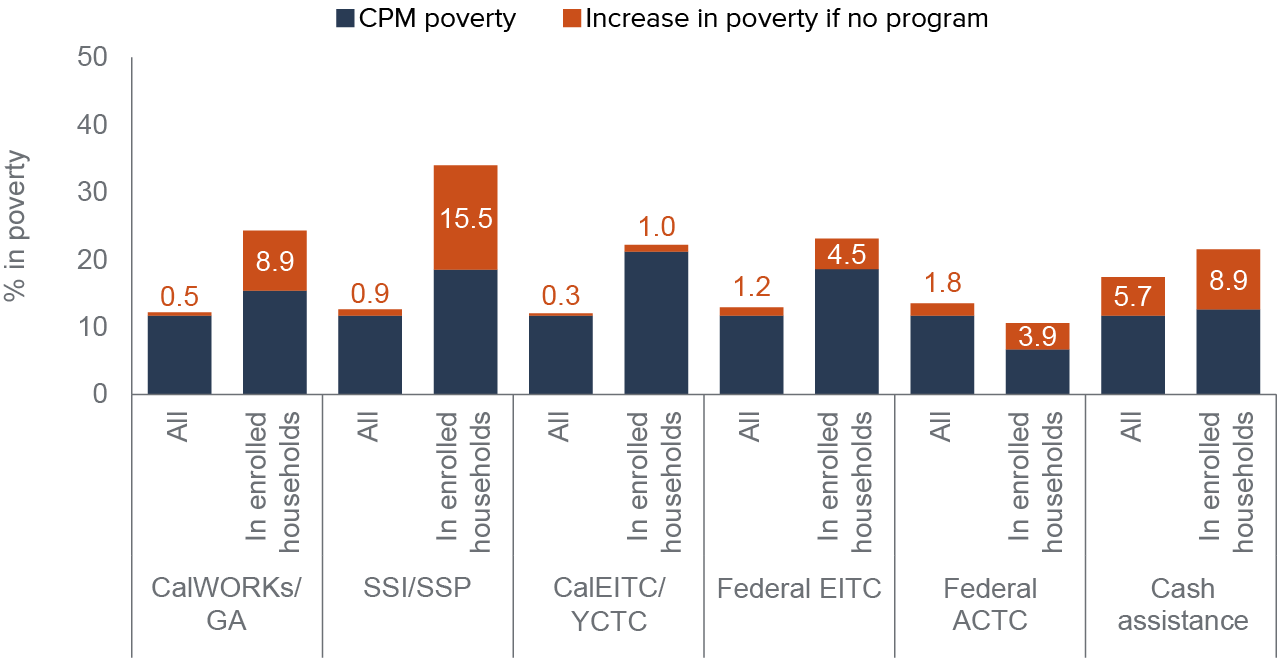Cash assistance programs help low-income Californians meet basic needs.
- Both cash and in-kind safety net programs help families meet basic needs. Eligibility requirements, funding sources, and oversight vary widely across key cash-based programs.
- According to the California Poverty Measure (CPM), these programs kept 2.1 million Californians—including 900,000 children—out of poverty in fall 2021. But not all who are eligible are enrolled.
- While tax credits reach more Californians, the California Work Opportunity and Responsibility to Kids (CalWORKs) and Supplemental Security Income/State Supplementary Payments (SSI/SSP) have the largest financial impact on participants, because both offer a higher level of support to people in extreme need.
Tax credits reach more Californians, but targeted programs provide more assistance to participants

SOURCE: California Poverty Measure, fall 2021.
NOTES: Program impacts shown for all people, and for those in households with any member enrolled. GA: general assistance. CalEITC/YCTC: California Earned Income Tax Credit/Young Child Tax Credit. ACTC: Advance Child Tax Credit. “Cash assistance”: combined impact of all programs. Program participation may be overlapping.
CalWORKs assists families, while General Assistance helps a small number of adults.
- CalWORKs provides monthly cash assistance to very low-income families with dependent children. Undocumented immigrants are ineligible but may have eligible family members (usually US-born children). Most parents must be working or making progress in work-related activities in order to remain eligible.
- In 2021–22, federal, state, and local spending for CalWORKs cash assistance totaled 3.7 billion. Since 2015, monthly maximum grants have increased from $704 to $1,130 for a family of three. Additional program funds go toward education, training, and employment services and support, including child care.
- Nearly four in five (79%) of the 774,000 participants are children. About 60% of eligible families participate in CalWORKs, according to recent estimates.
- County-run and -funded General Assistance (GA) programs assist about 130,000 low-income, working age adults per month who are not eligible for other cash assistance. Counties spent $390 million on GA in 2021–22—65% of it in Los Angeles County. Grants are typically time-limited and average $252 per month.
SSI and SSP assist low-income individuals who are disabled or age 65 or older.
- SSI assists low-income individuals who are blind, meet strict disability criteria, or are 65 or older; California augments this income with SSP. In addition, the California Assistance Program for Immigrants (CAPI) serves about 14,000 legal residents who do not meet additional non-citizen criteria for SSI.
- About 1.1 million people receive SSI/SSP monthly grants, mostly adults (43%) and seniors (49%). Participation has declined roughly 20% in the past decade.
- Federal benefits totaled $9.3 billion in 2021–22, while state benefits totaled $2.2 billion. After making cuts during the Great Recession, the state has been increasing SSP benefits in recent years. As of January 2023, maximum monthly SSI/SSP payments are $1,134 for individuals and $1,928 for couples.
Refundable tax credits help those with low—and sometimes no—earnings.
- Low-income earners who file returns get federal and state credits, including Earned Income Tax Credits (EITCs), the now-lapsed federal Advance Child Tax Credit (ACTC), and the state Young Child Tax Credit (YCTC). California now offers the YCTC regardless of earnings and a Foster Youth Tax Credit (FYTC) as of the 2022 tax year.
- The federal EITC averaged $1,857 for the 2021 tax year. The CalEITC can be claimed by undocumented immigrants and other filers who are ineligible for the federal credit. The combined CalEITC and YCTC credit averaged $291; very low-income filers with children under 6 could receive substantially more. Starting this year, the FYTC provides up to $1,083 to certain foster youth ages 18 to 25.
- The IRS estimates that about 75% of eligible Californians and their families (3.3 million tax filers and 8.3 million overall) received the federal EITC for tax year 2021. CalEITC was claimed by 3.6 million filers (and benefited 5.6 million people); 370,000 of these filers (and 1.1 million people) also got the YCTC.
- Federal EITC spending in California totaled $6.1 billion for tax year 2021; the state spent about $700 million for the CalEITC and $350 million for the YCTC.
Participation and funding vary widely across the state’s largest cash assistance programs
SOURCES: CDSS, SSA, IRS, FTB.
NOTES: Chart shows individuals participating and total expenditures in 2021. Monthly average participants shown for CalWORKs and GA; SSI/SSP participants as of December 2021; tax credit participants for CY 2021. Caseload turnover means that CalWORKs and GA participation is higher than shown here. Financial data are for SFY 2021-22 or CY 2021.
California is moving forward amid economic uncertainty.
- Now that substantial pandemic-era safety net expansions have expired, poverty is expected to rise in 2023.
- California faces a revenue shortfall for the first time in several years. Lawmakers cut CalWORKs and SSP during the Great Recession, but budget reserves and unexpended funds might prevent cuts this year.
- Several localities across the state are planning guaranteed income pilots that will reach about 12,000 low-income families. Funded by state, local, and private sources, these initiatives aim to test the impact of unconditional cash payments, prioritizing foster youth and pregnant individuals.
- Beyond considering new or expanded programs, policymakers can monitor equitable access and work on improving program participation among eligible Californians.
Topics
COVID-19 Health & Safety Net Poverty & Inequality




